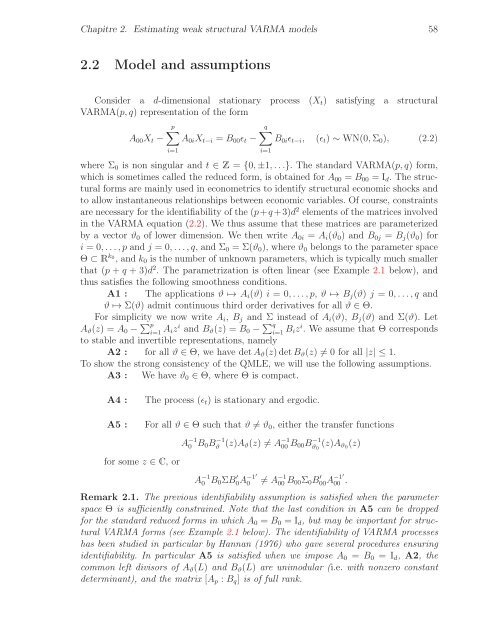THÈSE Estimation, validation et identification des modèles ARMA ...
THÈSE Estimation, validation et identification des modèles ARMA ...
THÈSE Estimation, validation et identification des modèles ARMA ...
Create successful ePaper yourself
Turn your PDF publications into a flip-book with our unique Google optimized e-Paper software.
Chapitre 2. Estimating weak structural V<strong>ARMA</strong> models 58<br />
2.2 Model and assumptions<br />
Consider a d-dimensional stationary process (Xt) satisfying a structural<br />
V<strong>ARMA</strong>(p,q) representation of the form<br />
p<br />
q<br />
A00Xt − A0iXt−i = B00ǫt − B0iǫt−i, (ǫt) ∼ WN(0,Σ0), (2.2)<br />
i=1<br />
where Σ0 is non singular and t ∈ Z = {0,±1,...}. The standard V<strong>ARMA</strong>(p,q) form,<br />
which is som<strong>et</strong>imes called the reduced form, is obtained for A00 = B00 = Id. The structural<br />
forms are mainly used in econom<strong>et</strong>rics to identify structural economic shocks and<br />
to allow instantaneous relationships b<strong>et</strong>ween economic variables. Of course, constraints<br />
are necessary for the identifiability of the (p+q+3)d 2 elements of the matrices involved<br />
in the V<strong>ARMA</strong> equation (2.2). We thus assume that these matrices are param<strong>et</strong>erized<br />
by a vector ϑ0 of lower dimension. We then write A0i = Ai(ϑ0) and B0j = Bj(ϑ0) for<br />
i = 0,...,p and j = 0,...,q, and Σ0 = Σ(ϑ0), where ϑ0 belongs to the param<strong>et</strong>er space<br />
Θ ⊂ Rk0 , and k0 is the number of unknown param<strong>et</strong>ers, which is typically much smaller<br />
that (p + q + 3)d2 . The param<strong>et</strong>rization is often linear (see Example 2.1 below), and<br />
thus satisfies the following smoothness conditions.<br />
A1 : The applications ϑ ↦→ Ai(ϑ) i = 0,...,p, ϑ ↦→ Bj(ϑ) j = 0,...,q and<br />
ϑ ↦→ Σ(ϑ) admit continuous third order derivatives for all ϑ ∈ Θ.<br />
For simplicity we now write Ai, Bj and Σ instead of Ai(ϑ), Bj(ϑ) and Σ(ϑ). L<strong>et</strong><br />
Aϑ(z) = A0 − p i=1Aiz i and Bϑ(z) = B0 − q i=1Bizi . We assume that Θ corresponds<br />
to stable and invertible representations, namely<br />
A2 : for all ϑ ∈ Θ, we have d<strong>et</strong>Aϑ(z)d<strong>et</strong>Bϑ(z) = 0 for all |z| ≤ 1.<br />
To show the strong consistency of the QMLE, we will use the following assumptions.<br />
A3 : We have ϑ0 ∈ Θ, where Θ is compact.<br />
i=1<br />
A4 : The process (ǫt) is stationary and ergodic.<br />
A5 : For all ϑ ∈ Θ such that ϑ = ϑ0, either the transfer functions<br />
for some z ∈ C, or<br />
A −1 −1<br />
0 B0B<br />
ϑ (z)Aϑ(z) = A −1<br />
00<br />
B00B −1<br />
ϑ0 (z)Aϑ0(z)<br />
A −1<br />
0 B0ΣB ′ 0A −1′<br />
0 = A −1<br />
00B00Σ0B ′ 00A −1′<br />
00 .<br />
Remark 2.1. The previous identifiability assumption is satisfied when the param<strong>et</strong>er<br />
space Θ is sufficiently constrained. Note that the last condition in A5 can be dropped<br />
for the standard reduced forms in which A0 = B0 = Id, but may be important for structural<br />
V<strong>ARMA</strong> forms (see Example 2.1 below). The identifiability of V<strong>ARMA</strong> processes<br />
has been studied in particular by Hannan (1976) who gave several procedures ensuring<br />
identifiability. In particular A5 is satisfied when we impose A0 = B0 = Id, A2, the<br />
common left divisors of Aϑ(L) and Bϑ(L) are unimodular (i.e. with nonzero constant<br />
d<strong>et</strong>erminant), and the matrix [Ap : Bq] is of full rank.
















